I thought after my recent look at the more angelic end of the avian spectrum it would be illustrative to descend into the circles of birding hell in order to regard, through the safety of the Internet, one of the baser demons in the pantheon of the birding gods. Our guide on this journey is not Dante but Henry Leon Dawson, a man who wrote extensively about birds at a time when writing was considered a form of verbal warfare and birding a brutal style of contact sport. One gets the impression that Theodore Roosevelt would have had Dawson’s books in his library, and would have nodded approvingly at the descriptions of rare birds (with a mind to take a gun and make them rarer no doubt).
Much that is good and all that is evil has gathered itself up into the Western Gull” he begins, a charitable introduction for what is essentially a wolverine in feathered form. The Western Gull is a relatively common marine gull found on the western coast of the United States and northern Mexico. Quite large by gull standards, it is “rather the handsomest of the blue-mantled Laridae, for the depth of color in the mantle, in sharp contrast with the snowy plumage of back and breast, gives him an appearance of sturdiness and quality” he says, adding more menacingly, “which is not easily dispelled by subsequent knowledge of the black heart within”. Clearly Dawson was not one to worry about hurting a gull’s feelings (not that such a thing is really possible)!
A Western Gull (Larus occidentalis) during a quiet, reflective moment.
My own encounters with the Western Gull were in the same location that Dawson met them, the Farallon Islands in California. These small rocky islands represent their fortress and domain, every bird and person on the island is subject to them. “It is at the breeding season, however, that the Western Gull accomplishes real mischief. While he effects a passable truce with his own kind at that season, it is that he may the better combine with his fellows and terrorize all other breeding sea-birds.” The island is also the largest colony of the species anywhere in their range, making it the capital of their tyrannical empire. You are never far from one anywhere on the island, and the constant noise ensures they are never forgotten even when it’s dark and you’re hiding under your blanket at night. And as I’ve related before, if you venture far outside the house during the breeding season, the gulls will mark their displeasure in a very firm way. Did I say firm? I meant squishy. Warm, damp and squishy. Followed by a firm smack with the bill.
This gull is triangulating the best angle at which to send Melinda tumbling down the cliff.
The passable truce Dawson alludes to is a precarious one, however. It covers a small area around the site chosen to rear their not-yet-demonic offspring, and each gull is safe so long as it remains inside the small area determined to be theirs. Should a gull leave that area and wander into the territory of another gull all bets are off. In fact, should anything smaller than an elephant seal wander into the territory it will be rewarded not only with copious amounts of warm milky guano but a thorough battering. A blind visitor might be able to guess how far along the breeding season was by the varying intensity of the attacks, which reached their zenith around hatching. Says Dawson of the parents “A company of some hundred adults, fathers perhaps, lay offshore and watched proceedings; but the mothers gave me earnest attention. Three times I was struck upon the head, always from behind, by vicious beaks, while I was engaged in the benevolent task of gathering up babies for a picture. A plague upon this photography of infants anyway! It is appreciated by neither parent nor child.” I don’t think he was correct about the differences in malevolence between the sexes, but you get the idea. Maps of the islands might very well be illustrated with the legend “here be dragons”.
The owner of this particular nest is on Alcatraz Island, where it endears itself by screaming at tourists all day long
One of the more interesting behaviour quirks of the Western Gulls is their demonstrated ability to recognize individual humans. This is seldom a good thing for the human being recognized. It was first identified when a scientist was working on catching banded adults to replace their bands. Western Gulls are malevolent at the best of times, but should you happen to grab and adult bird – or a dead adult- within seconds every gull in the area is in the air around you in a swirling whirlpool of screaming anger. The effect, a feathered maelstrom, is genuinely disconcerting. Soon the scientist couldn’t continue his work, every time he left the house the entire colony was up in the air screaming, even if he wasn’t trying to catch gulls. But when he started wearing a new hat and a mask the gulls were fine. Take the mask off, and they went crazy again. Most of us didn’t have to catch adults, so when never got such extreme reactions. But we all have gull individual plots where we work to record the breeding success of numerous breeding gulls, and each of us was a familiar targets in those plots, recognized by the birds in them and attacked more than the rest of the crew for our trouble! It was possible to stand in their territories and have a gull swoop, scream, hit, gain hight, swoop, scream, hit, and continue in a regular fashion like a demented and violent timepiece.
Indeed the gulls were much better at recognising us than we were them. To identify an individual gull we needed to read the long band number on the metal bands on their leg with binoculars, a complicated process when moving around the bird to continue reading the numbers usually resulted in the bird moving itself so as to continue keeping you in front of it. There were a few exceptions of course, a few easily recognised gulls. Like for example the Hoarse Gull, which due to some deficiency in its throat was forever unable to vocalise the deep anger it felt at the world (and us in particular). Or the Nibbler, which lived near the house and didn’t swoop dive us but instead ran up behind and nipped us on the achilles tendon. Worst of all was the Troll, which nested next to the eponymous Troll Bridge, a thin plank of wood halfway up a cliff trail to a murre observation hide. Crossing the bridge was alarming enough without the Troll hurtling at you.
Lots of gulls. If you had any particular reason to get to the top of this hill each and every one of these guys would have a lot to say about it.
The Western Gulls also attacked the smaller birds on the island as well, a fact Dawson faithfully recorded. “Nothing in the life of the Farallons is more striking than the rapacity of the gulls and their determination to profit by any excitement which will frighten the peasantry. No matter if their own homes are threatened, ‘Rob the Murres,’ they shout, and off they go to try for weak places. “ He then wanders dangerously into the territory of hyperbole, adding “It has its historical analogies only in the persecution of the Christians at Rome or in the ‘Jew baiting’ of the Middle Ages. An idle mob finding itself assemble for any cause and cheated of its first object, proceeds to do mischief to the favorite weaklings.” Some gulls are particularly good at hunting the Ashy Storm-petrel, a species which also has its stronghold on this island. In addition to hunting birds on the island Western Gulls take a wide range of food items, and like many gulls they are not above raiding rubbish tips. In fact the island is strewn with the debris collected from the tips along with the food, the more interesting items of which are collected for the gull juju box.
Gull juju. Some of the more interesting items found by foraging gulls are collected.
If the gulls are at their most aggressive when they have young chicks, this often does not benefit the chicks. Dawson notes on the behaviour of the smaller chicks “The danger sign had, of course, been passed around, and not a youngster on the island but froze in his tracks, no matter where he happened to be… In some instances, if the chick knew himself discovered, he felt free to shift his position with a view to betterment. But instinct did not serve a whit to guide the chicks in such efforts, and they were as likely to topple off a precipice as to find a safer haven.” Or, if no precipice is available, or even no threat, chicks will wander off the territory protected by their parents, whereupon the same attacks that we endure with hard hats are endured by tiny defenseless chicks. Chick mortality is stunningly high, and you have to harden your heart to bleeding, dying birds everywhere you go on the island when the chicks start wandering. On occasion your scientific detachment snaps and you throw a rock at the adult, scoop the battered chick up and shove the little guy into a nook where it can recover. With such awful childhoods it seems hardly surprising Western Gulls grow up to be such dysfunctional adults!
Although this pair has managed to raise one of their three chicks, inside that chick is already dead, and in five years time or so it will return to attack biologists, murres, storm-petrels and most importantly other gulls like its parents before it.
In spite of all of the above, I confess to being moderately fond of the Western Gull. Perhaps it is because of all of the above. They are the kind of villain you root for, one that makes no effort to hide its true nature, nor make any excuse for it. They are to my mind the wildest of the gulls, a already much unappreciated and unloved family of birds (even amongst birders), and they bring a dash of the true wild to the streets and shores where we meet them. I think that Dawson was fond of them too, in a way, and I’ll leave you with a few lines of his that both sum up the species and to me are some of the best words ever written about birds.
“Call him a ghoul, rather, for the Western gull is cruel of beak and bottomless of maw. Pity, with him, is a thing unknown; and when one of their own comrades dies, these feathered jackals fall upon him without compunction, a veritable Leichnamveranderungsgebrauchsgesellschaft. If he thus mistreats his own kind, be assured that this gull asks only two questions of any other living thing: First, “Am I hungry?” (Ans., “Yes.”) Second, “Can I get away with it?” (Ans., “I’ll try.”)”
***
Text from William Leon Dawson’s “The Birds of California: A Complete and Popular Account of the 580 Species and Subspecies of Birds Found in the State“. Published in 1923.
Most of the images are mine, but the top one is by an unknown Farallon intern.

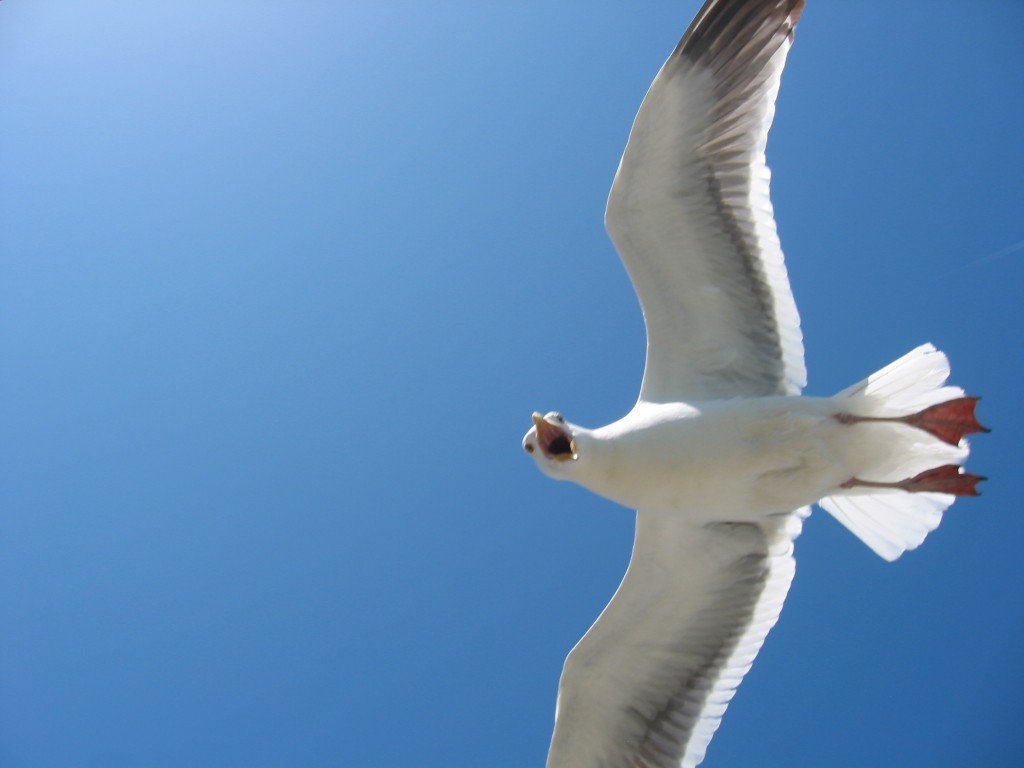
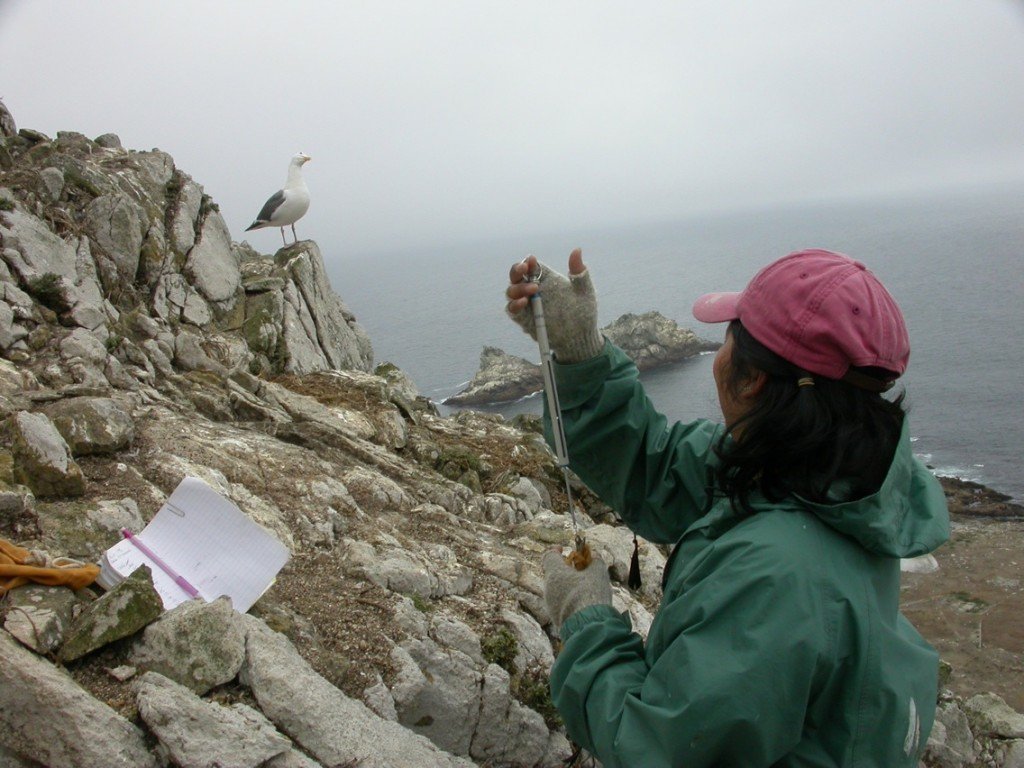
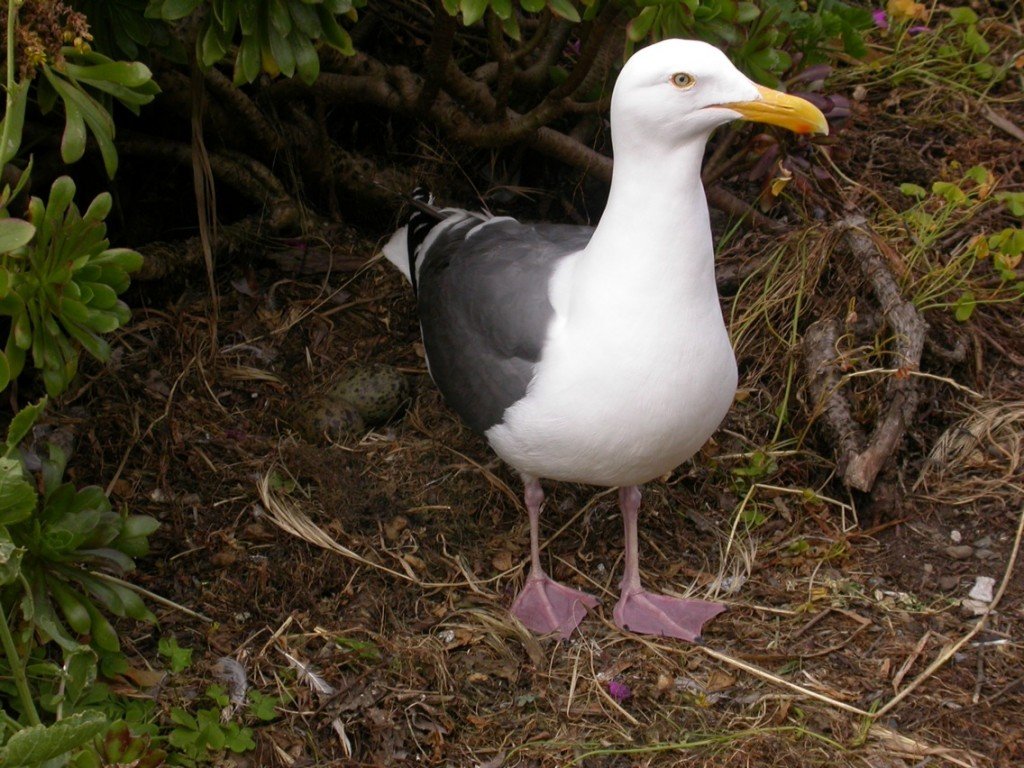
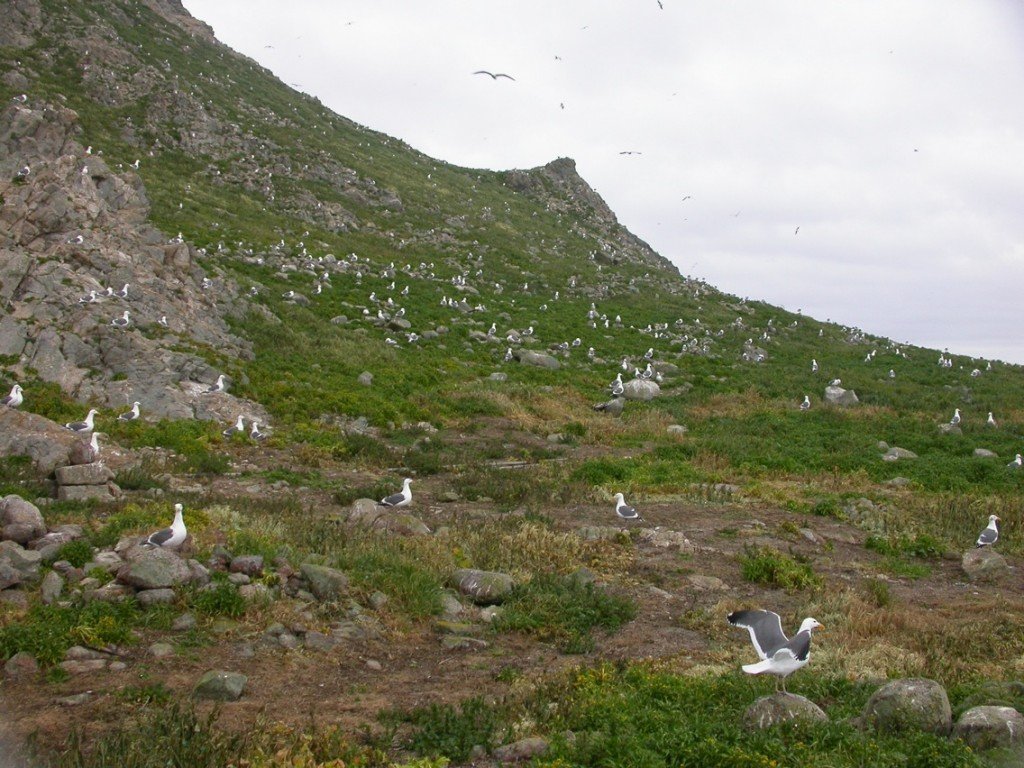

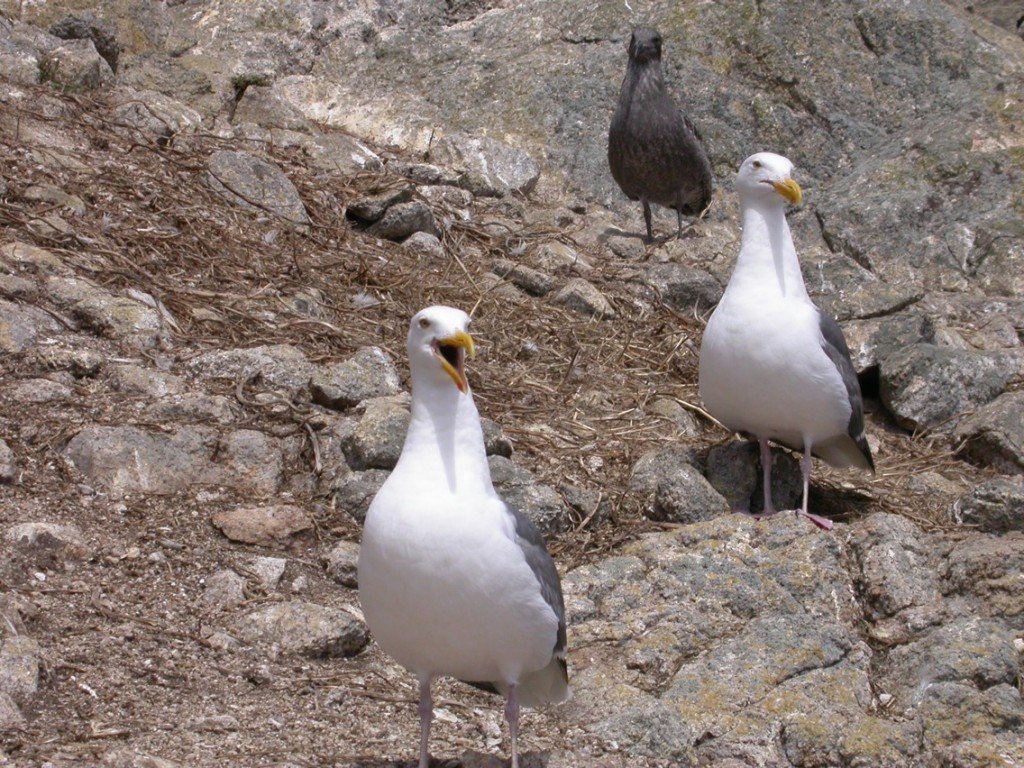










Awesome. This post rocks.
Now I have to wonder what the Great Black-backed Gull is like on breeding territory…
Brilliant, Duncan. Gulls don’t normally hold much interest for me, but this piece fascinates me.
Fantastic post! Bird blogging excellence there.
Great post and after the Raven post makes one glad Eagles haven’t gained the mob mentality when it comes to chasing people and hunting .
I have a soft spot for gulls, despite the rampant gull-hate amongst the unconvinced.
I can’t really explain it. They’re just my kinda bird.
also, lol@juju box.
Great post Duncan! Your descriptions are dead on and I can feel the mix of admiration and loathing you still feel for the WEGU. I’m sure those gulls on K-plot will never forget Big Beak O’Riley and the red hard hat!
Having been attacked by those very same marvelous and ruthless gulls, I salute you for this accurate and hilarious blog post!
Ah, memories. Thanks, Duncan!